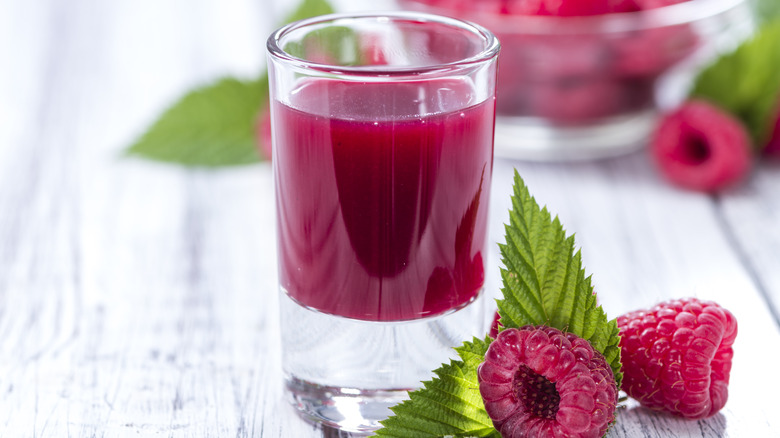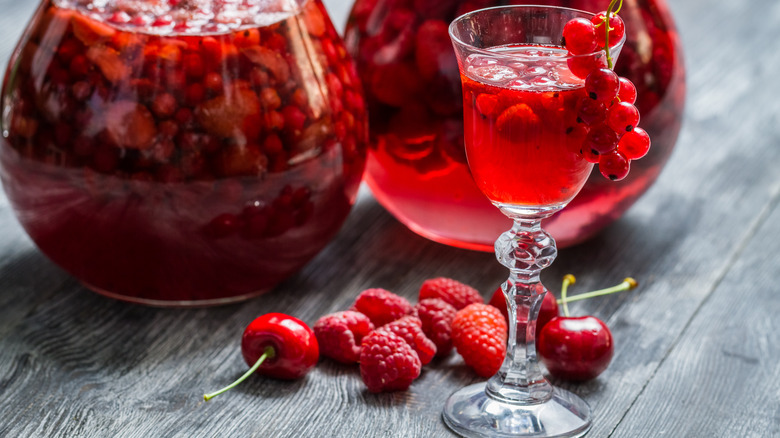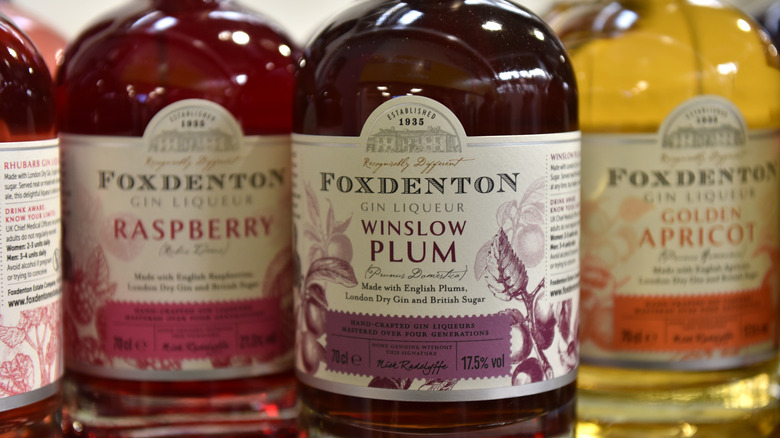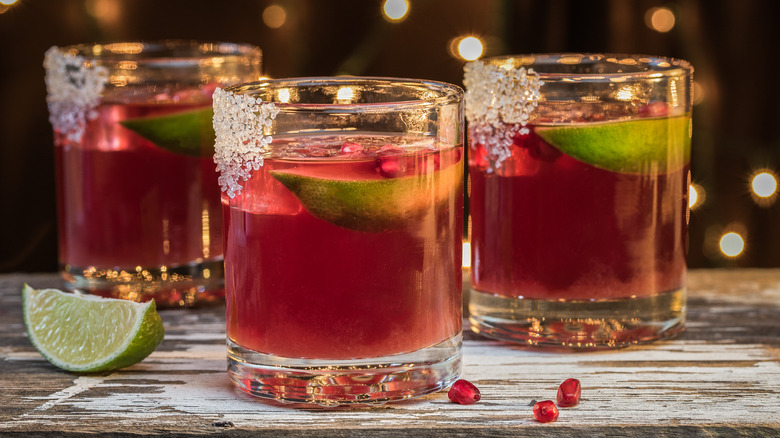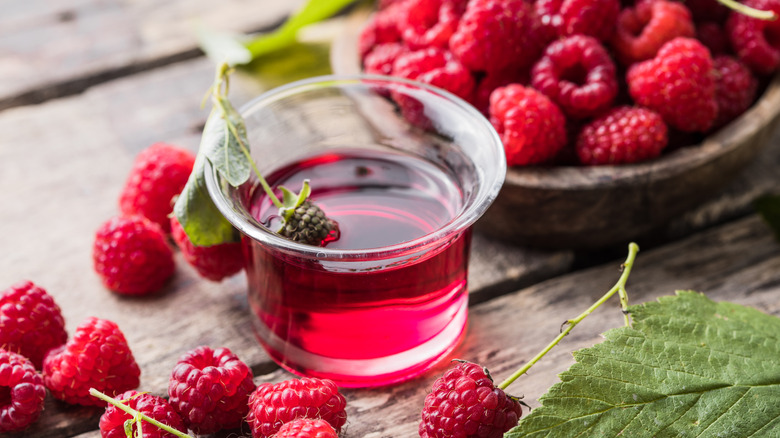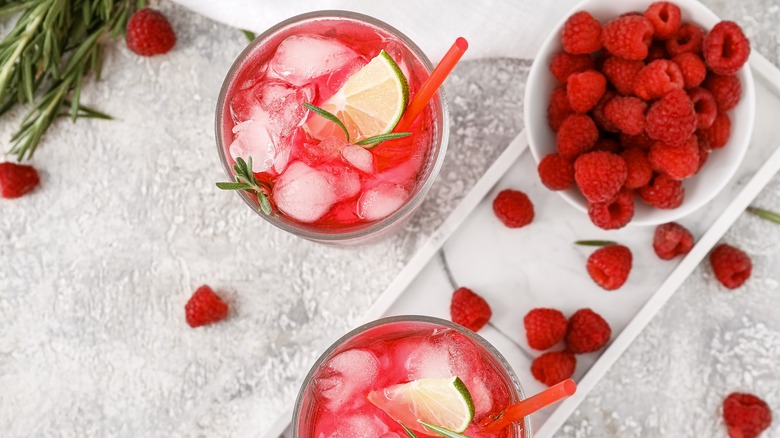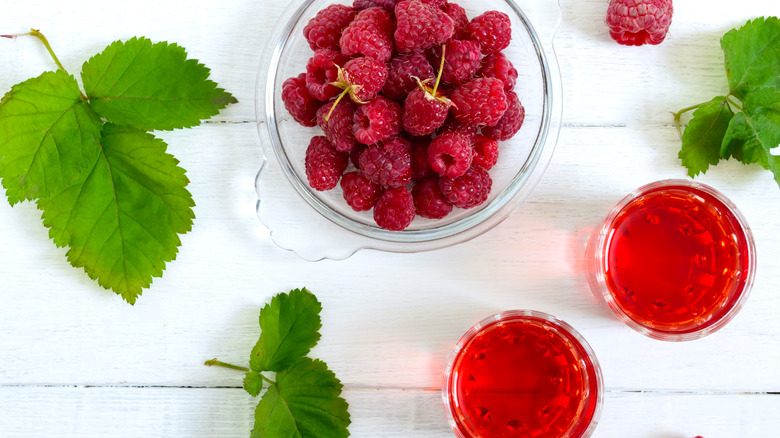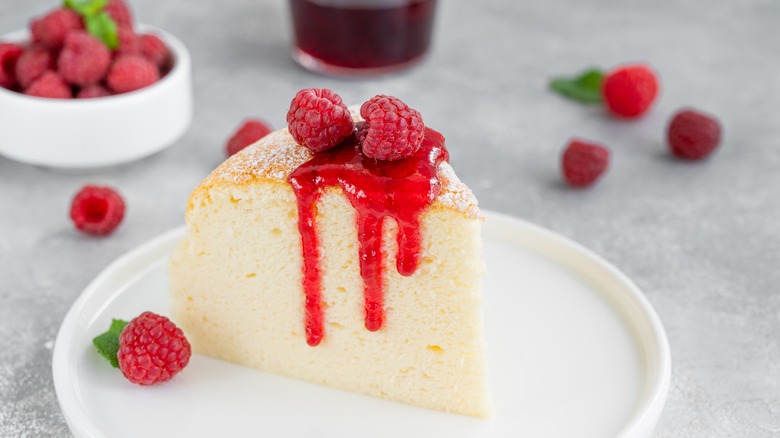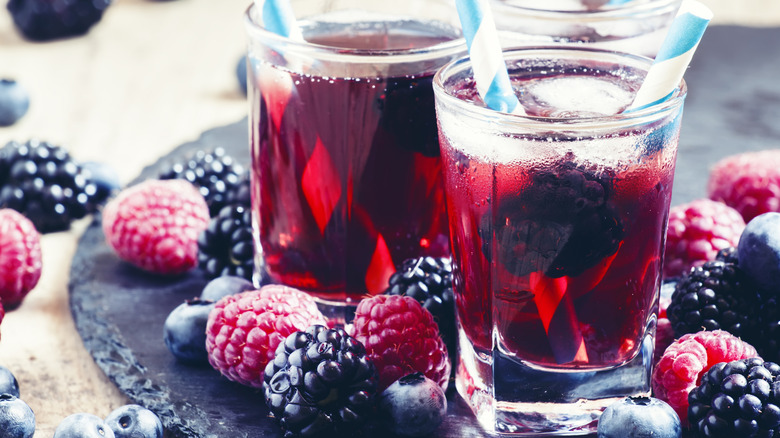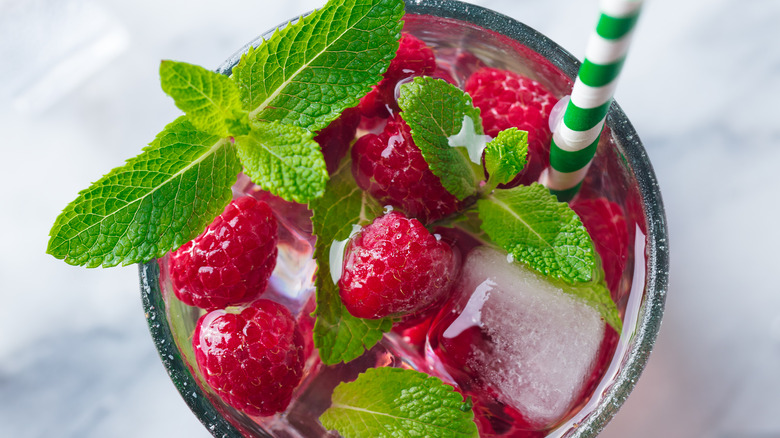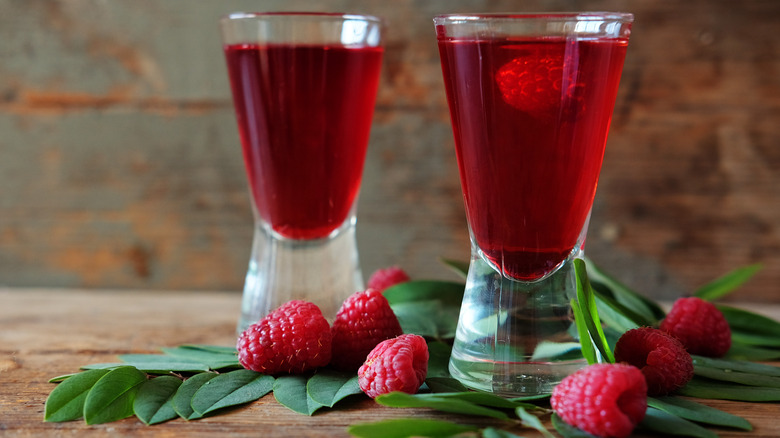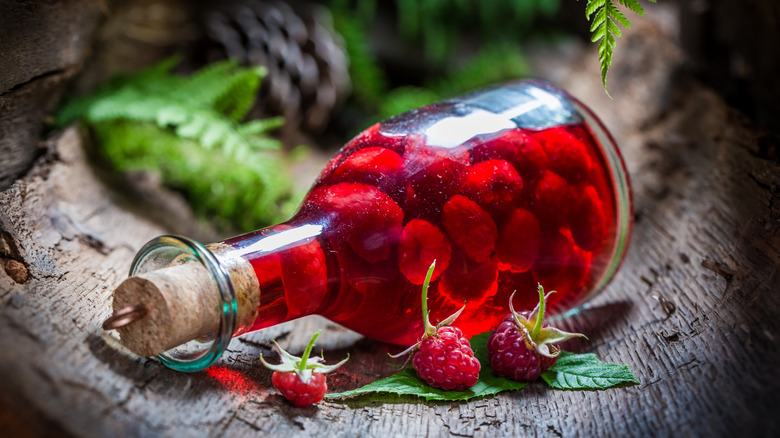Should You Buy Or Make Your Own Framboise Raspberry Liqueur?
The word "liqueur" might sound like "liquor," but don't let the linguistic similarities fool you. While both liqueur and liquor do contain alcohol, the biggest difference between the two substances is that liqueur has to be sweet (via Senior & Co.). According to the standards set by the European Union (per Bols), a drink must contain a minimum of 100 grams of sugar per liter to earn the coveted title of "liqueur." On top of that, the liquid must have an ABV of at least 15%. These strict regulations are what ensure that the liqueur sold on the market is both sweet and strong.
The unique and complex flavor of liqueur has made it a popular drink among humans for centuries. As per Senior & Co., some of the oldest known liqueur recipes have been discovered in artifacts from ancient Greece and Egypt. In medieval Italy, monks were entrusted with the responsibility of producing these substances. And while a lot of people in the Middle Ages used them as medicine, the Encyclopedia Britannica explains that some people from the past even believed that liqueurs were love potions.
Because of the rich history surrounding liqueur production, you might want to make one at home. Framboise raspberry liqueur is a particularly delightful choice as it combines bitter fruity flavors with a deep sweetness. However, before you get to work in the kitchen, you should consider whether DIY framboise raspberry liqueur is actually a better choice than the professionally produced variety.
What is framboise raspberry liqueur?
True to its name, framboise raspberry liqueur is a type of liqueur made using raspberries. The word "framboise," meaning "raspberry" in French, is a nod to the liquid's rumored origins at a chateau around two hours south of Paris (via Australian Bartender). The old story goes that King Louis XIV tasted this delightful drink for the first time on a visit to the Chambord Castle during the latter half of the 17th century, a time when raspberry liqueurs were increasing in popularity (per VinePair).
Likely because of this history, one of the world's most famous brands of commercial raspberry liqueur was named Chambord Liqueur, calling to mind the castle where the Sun King first enjoyed this beverage. And while VinePair notes that the brand didn't hit the market until the 1980s, the historic liqueur maintains something of a traditional touch. In fact, the Chambord Liqueur formula is based on a recipe that dates back to the 1600s. As the brand's leader, Michel Gayraud, told Australian Bartender, "Today, Chambord [Liqueur] continues to be a part of that tradition, steeped in the French history and methods founded over 300 years ago."
While Chambord's traditional recipe includes vanilla and citrus peels, per the brand's official website, not all raspberry liqueurs involve so many elements. For example, St. George brand raspberry liqueur tries to focus its recipe on two main ingredients: raspberries and cane sugar (per St. George Spirits).
The cost of store-bought raspberry liqueur
While Chambord Liqueur is certainly a popular brand, there are other commercial framboise raspberry liqueurs available in several different price ranges. On the higher end of the spectrum, there is Oxton Raspberry Gin Liqueur, which you could use to add a fun twist to the classic bee's knees cocktail. According to The Oxton Liqueur Company's official website, a 500-milliliter bottle of their brew costs 40 British pounds, which is approximately 48 U.S. dollars. While this might sound pricey, it's worth noting that the Oxton fruit liqueur brand has won more than a dozen awards for its high-quality products (via The Game Fair).
In terms of more reasonably priced raspberry liqueur options, Jahiot Creme de Framboise is a French brand that has received high praise from Wine Enthusiast. A 375-milliliter bottle of this European treat costs $18.99 on Drizzly, placing it at a much more accessible price point. However, neither of these two choices is as affordable as Dr. Bramble's Gin Liqueur, which is listed on Total Wine as costing 16.99 for a large 750-milliliter bottle of fruity goodness.
Interestingly, Chambord's traditional raspberry liqueur is more of a mid-range choice. On Drizzly, a 375-milliliter bottle of the traditional French concoction is priced at $21.99. Meanwhile, an even larger 750-milliliter bottle is available for $35.99.
The differences between commercial raspberry liqueur brands
The price points aren't the only factor that distinguishes one framboise raspberry liqueur brand from the next. The ingredients, and therefore flavors, of these liqueurs also vary considerably. The reason for this is that not every liqueur brand uses the same type of alcoholic base in its recipe. According to the Chambord Liqueur website, the classic raspberry beverage is made using an aged cognac. Meanwhile, as evident in their names, both Oxton Raspberry Gin Liqueur and Dr. Bramble's Gin Liqueur use a gin base, giving them a slightly sharper flavor.
Because of this, anyone considering store-bought framboise liqueur should think about whether they prefer a brand with a rounder cognac base or a tangier gin one. Cognac-based liqueurs can work well in anything from a French Martini to a glass of liqueur-spiked Frose. On the other hand, gin-based liqueurs are best enjoyed in spritzes or fizzy soda. One delicious idea is to make a classic Aperol Spritz, replacing the Aperol with a dash of Dr. Bramble's. Switch out the orange garnish for a berry one and drink up!
How to DIY framboise raspberry liqueur
The idea of making your own liqueur might seem intimidating, but the actual process is fairly simple. At the end of the day, you can technically make framboise liqueur by soaking raspberries and sugar in any grocery store liquor until the spirits take on the fruit's flavor. Of course, it's best to be selective about the quality of liquor and fruit that you use in your creation, as high-quality ingredients make all the difference when it comes to liqueur production. St. George's Raspberry Liqueur, for example, doesn't even make their delicious drink on years when the raspberry harvest is not up to standard (via St. George Spirits). Because of this, you should start out with some fresh raspberries and a type of liquor that you really like.
If you're unsure which liquor to use, you could stick to the classics and infuse cognac or another type of brandy. Alternatively, you could always consider making infused vodka since this Russian liquor is famous for easily combining with other flavors (per Macalester College). Once you've chosen your poison, just add some fruit and a sweetener to your liqueur. Then, let the mixture soak. The Crowded Kitchen recommends letting most fruit infusions sit for about three to five days but suggests letting berry liqueurs soak for a whole week.
The hidden costs of DIY liqueurs
Although making framboise raspberry liqueur at home isn't complicated, it is also far from being free. In some cases, it's actually more expensive to make DIY liqueur than it is to just buy it. The reason is that this special beverage contains somewhat pricey ingredients. Raspberries, for example, aren't the cheapest fruit on the market, as they cost around $8.42 per 16-ounce package, according to Frugal Answers. Organic raspberries are even more expensive, with a smaller 6-ounce package costing up to $5.99.
As if raspberries weren't pricey enough, liquors like vodka, gin, and cognac are also expensive. As per Bottled Prices, a bottle of standard Smirnoff vodka can cost you around $13. More famous brands, such as Grey Goose, are even pricier at approximately $35 per bottle. Because of this, homemade framboise raspberry liqueur can easily cost you $20 — or, even more, if you are concerned about the quality of your ingredients. Once you factor in the extra time and effort that goes into making DIY liqueurs, it should be clear that making homemade liqueur is not necessarily the most budget-friendly option.
Common raspberry liqueur DIY mistakes
Making framboise raspberry liqueur is relatively simple, but that doesn't mean that it's impossible to make a mistake. During the DIY liqueur process, a couple of common missteps could throw off your whole creation. One such slip-up, according to Fruit Experts, is forgetting to wash the berries before starting the infusion.
The reason for this could pertain to the status of raspberries as one of the most contaminated foods when it comes to pesticides. As noted by Prevention, in one random sampling conducted by the USDA and FDA, 58% of the raspberries were contaminated with at least one of 39 different chemicals. Unfortunately, if not washed properly, your raspberries could end up adding unwanted substances and their unexpected flavors to your infusion.
In order to prevent this mistake, try following the USDA guidelines on cleaning your berries. As recommended by the organization, you shouldn't rinse your raspberries immediately after purchasing them. Instead, try washing your fruit right before you use it. Since water-soaked fruit tends to rot more quickly, make sure that you pat your berries dry before adding them to the infusion. This can also ensure that your proportions will be correct, leaving you with that fruity flavor that framboise liqueur is so famous for.
Think about how much liqueur you actually need
Unlike chocolate liqueur or even coffee liqueur, framboise raspberry liqueur is only rarely consumed in its pure form. Most people enjoy it mixed into another drink, and it can even be used as a substitute for creme de cassis in this two-ingredient French wine cocktail. Others use framboise liqueur to flavor a dessert. A fruit salad topped with a Chambord-infused whipped cream adds a fun twist to an otherwise basic combination of ingredients.
However, when deciding if you should buy or DIY, the first thing you need to do is determine how much liqueur you will need for the final product that you have in mind. Some recipes call for only a few drops of liqueur, as they use the substance as a garnish. If you are planning on cooking a raspberry and champagne cake, for example, you probably won't need to spend days preparing homemade liqueur. After all, the recipe only requires 2 tablespoons of framboise liqueur.
On the other hand, there are plenty of cocktail recipes that rely heavily on the raspberry liqueur component. Depending on how many cocktails you are planning to serve, you might even need a full bottle of liqueur. In this case, it would make more sense to embark on the multi-day journey of infusing your liquor of choice.
How quickly does framboise raspberry liqueur spoil?
When deciding whether to make a batch of framboise raspberry liqueur or simply purchase it, you may wonder how long the substance keeps for. Unfortunately, there is no easy answer to this question, as the variations between liqueur recipes render very different products, both in terms of sugar content and alcohol percentages. Chambord Liqueur, for one, is best consumed between three to four months after you first open it, as per Foods Guy. And, while the classic beverage won't necessarily spoil in this amount of time, it will likely lose some of its signature flavors.
If you are hoping to maximize your liqueur's shelf life, there are some tips and tricks that can help you achieve this. According to a report by Today, you should try to keep your framboise raspberry liqueur out of the freezer. As mixology expert Jason Cott told the outlet, "No spirit should ever be stored in the freezer if you want to use it in a cocktail ... making it super cold takes away some of the flavor and makes it lose its botanicals and floral essences."
On the flip side, liquor experts recommend keeping your booze out of the sun. As reported by Wired, scientists hired by Bacardi conducted a study to see how heat and light impacted a spirit's quality. They found that exposure to heat and light can, respectively, break down a liquor's molecules and eliminate its natural color.
How to use leftover raspberry liqueur
If you are worried about using all of your leftover liqueur before the expiration date, do not despair. The sugary tartness of this ingredient pairs quite nicely with plenty of desserts. Even the oh-so-picky Michelin Guide (via Le Collectionsit) has recognized the strength of this flavor combination, as its restaurant critics lauded the mixture of chocolate, raspberry, and lemon in a verbena at a Portuguese restaurant called EPUR. To emulate this impressive dish, try making chocolate cake and drizzling some raspberry framboise liqueur on top. Garnish your final product with bits of lemon rind if you want to embrace the full spectrum of these interesting flavors.
Alternatively, you might want to use your leftover raspberry framboise liqueur in a cocktail. If you have a gin-based liqueur lying around, you might consider making this raspberry thyme cocktail, replacing the Bombay gin with your framboise infusion. Since liqueurs are a bit thicker than most spirits, you should add a tad more club soda to your final creation. For something even lighter, you could try making raspberry lemonade punch and spiking it with a dash of your fun fruity liqueur.
Best reasons to buy framboise raspberry liqueur
There are plenty of reasons to choose store-bought framboise raspberry liqueur over its DIY counterpart. Commercial liqueurs don't take days to stew, they are relatively inexpensive when compared to homemade ones, and they come with clear expiration dates so you're never in the dark about their shelf life. Additionally, in contrast to DIY liqueurs, store-bought brands tend to guarantee a certain quality. This means that when you buy them, you know exactly what to expect.
In addition to the consistency of store-bought liqueurs, many of these delicious drinks involve methods that aren't necessarily replicable at home. As mentioned in Vine Pair, Chambord raspberry liqueur is produced using a rather lengthy, multistep process. To make this framboise treat, the first round of raspberries is bathed in liquor for six weeks. The resulting infusion is set aside, and the previously soaked berries are then added to a new round of spirits, where they sit for an additional 14 days. Once again, however, the resulting infusion is set aside, while the raspberries remain.
Only after this intensive, eight-week-long tenderizing process are the raspberries finally removed from the spirits to be pressed. The resulting juice is mixed with the first two infusions, as well as aged cognac, Madagascan vanilla extract, and Moroccan orange peel extract to create the final product. It goes without saying that replicating such a complicated process at home would be way more challenging and costly than simply buying a bottle of Chambord.
Best reasons to DIY framboise raspberry liqueur
Making framboise raspberry liqueur at home might not be the easiest route. However, this doesn't mean that you shouldn't take on the challenge. On the contrary, making DIY liqueurs can be fun, and science shows that it can actually be good for your self-esteem.
In an issue of the Scientific American, behavioral neuroscientist Kelly Lambert explains that humans actually benefit from making things. "Our brains are programmed to derive a deep sense of satisfaction and pleasure when our physical effort produces something tangible, visible and ... meaningful in gaining the resources necessary for survival," Lambert writes. As a result, producing a bottle of homemade raspberry liqueur could give you what Lambert called "effort-driven rewards," or a sense of achievement for physically producing something.
The best part of this mental boost is that it's essentially a gift that keeps on giving — literally. According to Live Science, people often prefer receiving homemade gifts over store-bought ones because they find them to be more personal. Because of this, you might consider making a batch of DIY framboise raspberry liqueur to give your loved ones as presents. Your friends and family will likely appreciate the time and energy that you put into making them such a delightful gift.
